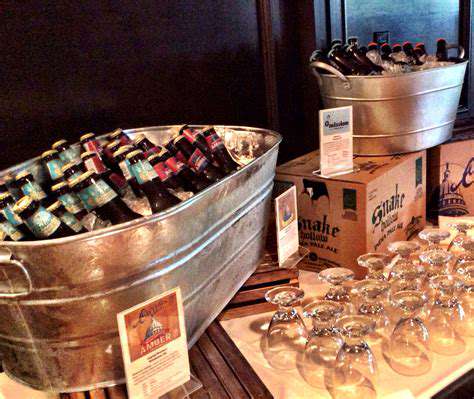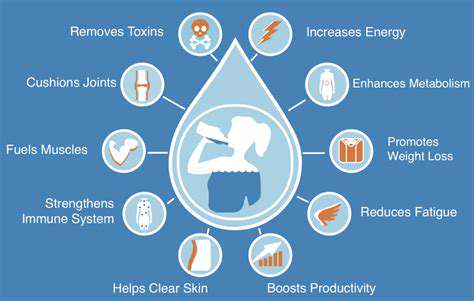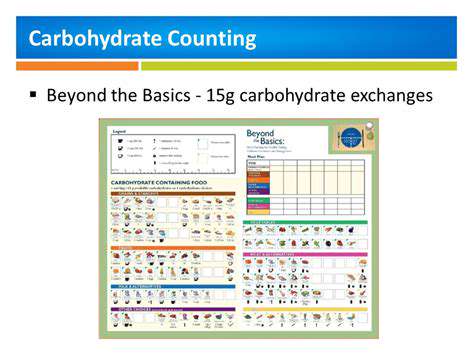The Science of Leavening in Baking (Yeast, Baking Soda)
Understanding the Fundamentals of Yeast
Yeast, a single-celled fungus, plays a crucial role in leavening, the process that creates the airy texture in baked goods. Its remarkable ability to ferment sugars, primarily from starches in flour, produces carbon dioxide gas. This gas, trapped within the dough, creates pockets that expand and rise, giving bread, pastries, and other baked goods their characteristic volume and light texture. Understanding the basics of yeast's biology is fundamental to mastering the art of baking.
Yeast thrives in warm, moist environments and requires specific conditions for optimal fermentation. Factors such as temperature, hydration, and the presence of nutrients directly influence its activity. The specific types of yeast, whether baker's yeast or other specialized strains, also affect the final outcome of the baking process, impacting the flavor, texture, and rise of the baked goods.
The Science of Fermentation
Fermentation, the process driven by yeast, is a fascinating biological transformation. Yeast consumes sugars, converting them into energy and releasing carbon dioxide as a byproduct. This carbon dioxide gas is what causes the dough to rise. Beyond the simple rise, fermentation also contributes to the development of complex flavors and aromas in baked goods. The chemical reactions during fermentation produce esters and other compounds that contribute to the unique flavor profiles of different breads and pastries.
Different Types of Yeast and Their Applications
Baker's yeast, a common type of yeast used in baking, is a crucial ingredient for achieving a light and airy texture in baked goods. Different types of yeast, such as compressed yeast, active dry yeast, and instant yeast, may vary in their activation times and applications. The choice of yeast type can influence the rise time and the final characteristics of the baked product. Understanding the specific properties of each type is essential for bakers to achieve desired results.
Beyond baker's yeast, other specialized yeast strains are employed in the production of specific types of bread and other fermented foods. These specialized strains offer unique flavor profiles and textures, showcasing the versatile nature of yeast in the culinary world. For instance, sourdough starter, a naturally occurring culture of yeast and bacteria, contributes distinct flavors and a complex crumb structure to breads.
The Role of Nutrients and Environment
Yeast, like all living organisms, requires specific nutrients to thrive. The presence of sugars, particularly from starches in flour, provides the energy source for yeast fermentation. Other nutrients, such as minerals and vitamins, also play a role in yeast's activity and overall health. Creating an optimal environment with the correct temperature and moisture levels is critical for successful yeast fermentation.
Troubleshooting Yeast-Related Issues in Baking
Yeast inactivity or underperformance can lead to disappointing results in baking. Understanding the potential causes of these issues, such as improper storage of yeast, inadequate hydration levels, or incorrect fermentation temperatures, can help bakers troubleshoot and achieve desired results. Knowing how to identify and address these issues is a crucial aspect of mastering the art of baking with yeast.
Problems like a dough that doesn't rise, or a flat or dense baked good, can often be traced to yeast-related issues. Careful observation and attention to detail in the baking process can help identify and remedy these issues, leading to consistently successful results in baking with yeast.
Beyond the Basics: Factors Affecting Leavening

Beyond the Fundamentals of Effective Communication
Effective communication is more than just exchanging words; it's about conveying a message clearly, concisely, and persuasively. This often involves understanding your audience and tailoring your message to their specific needs and interests. Effective communication fosters understanding and strengthens relationships, both personally and professionally. It also involves active listening, empathy, and a willingness to adapt to different communication styles.
Understanding Your Audience: A Crucial Element
Knowing your audience is paramount to effective communication. Understanding their background, perspectives, and expectations allows you to craft a message that resonates with them. This includes considering their level of knowledge on the topic, their emotional state, and their cultural context. By tailoring your communication to your audience, you increase the likelihood of achieving your desired outcome. Furthermore, adapting your tone and language to suit the audience is essential for successful communication.
The Power of Active Listening and Empathy
Active listening is a fundamental aspect of effective communication. It's not just hearing the words being spoken; it's about truly understanding the speaker's message, both verbally and nonverbally. This involves paying close attention to the speaker's body language, tone of voice, and underlying emotions. Empathy, the ability to understand and share the feelings of another, plays a crucial role in active listening. Demonstrating empathy fosters trust and rapport, making communication more meaningful and productive.
The Importance of Clarity and Conciseness
Clarity and conciseness are essential for effective communication. Avoid jargon, ambiguity, and unnecessary complexity. Using precise language ensures your message is easily understood and avoids misinterpretations. Get straight to the point and avoid rambling or digressing. Effective communication demands that you present your ideas in a clear and concise manner.
Overcoming Communication Barriers
Communication barriers can significantly hinder the effectiveness of any interaction. These barriers can include differing cultural backgrounds, language differences, physical disabilities, or even emotional obstacles. Addressing and overcoming these barriers is crucial for fostering understanding and building strong relationships. Strategies for overcoming these obstacles include using clear language, employing visual aids, and seeking clarification when needed. Understanding and acknowledging potential barriers is key to fostering successful communication.
The Role of Nonverbal Communication
Nonverbal communication, such as body language, tone of voice, and facial expressions, often carries a significant amount of weight in any interaction. It can either reinforce or contradict the verbal message. Understanding and interpreting nonverbal cues is essential for effective communication. Paying attention to these cues allows for a more nuanced understanding of the message being conveyed. Misinterpreting nonverbal cues can lead to misunderstandings and miscommunications. Therefore, accurately reading nonverbal communication is vital for successful interactions.
Optimizing Your Baking Results: Tips and Techniques

Understanding Oven Temperatures
Accurately calibrated oven temperatures are crucial for consistent baking results. Many ovens deviate from the displayed temperature, leading to unevenly cooked goods. Investing in an oven thermometer is a worthwhile investment to ensure accurate readings. This allows you to adjust your recipes accordingly, guaranteeing perfectly baked treats every time. Baking at the correct temperature is essential for achieving the desired texture and flavor.
Understanding how your oven behaves is also important. Different ovens have different heating patterns. Some ovens may heat up faster on one side than the other, which can cause uneven baking. Experimenting with different positions within the oven for your baking pans can help you mitigate these issues and achieve a more uniform outcome.
Ingredient Quality and Measurement
The quality of your ingredients significantly impacts the final product. Using fresh, high-quality ingredients is essential for achieving the best possible results. Using stale or low-quality ingredients can result in a noticeably different flavor and texture in your baked goods. Fresh ingredients, especially those such as butter and eggs, can dramatically improve the outcome.
Accurate measurements are just as important as using high-quality ingredients. Baking is a precise science, and deviations in ingredient quantities can drastically alter the final product's texture and flavor. Using precise measuring tools, such as digital scales for dry ingredients and measuring cups for liquids, can help you ensure accuracy and consistency in your recipes.
Proper Mixing Techniques
Mixing ingredients correctly is vital for developing the desired texture and structure in your baked goods. Overmixing or undermixing can lead to a variety of problems, from a tough cake to a dense cookie. Understanding the proper mixing techniques for different ingredients, and knowing when to stop mixing, is crucial for achieving optimal results.
Resting and Chilling Times
Allowing doughs and batters to rest or chill before baking is often overlooked, but it's an essential step for producing the best results. Resting times allow the gluten to relax, which can result in a softer, more tender final product. Chilling doughs helps to prevent spreading and maintain a beautiful shape for pastries.
Proper resting and chilling times can significantly enhance the texture and final appearance of your baked goods. This is especially important for items like cookies, pastries, and bread. Ignoring these steps can lead to a less appealing and potentially less flavorful result, so it's worth the effort to give your dough the time it needs to develop properly.
Baking Techniques and Tools
Different baking techniques, such as using a baking sheet or a specific pan, will influence the final product. Understanding these techniques helps tailor the baking process to the specific recipe and desired outcome. Using appropriate baking tools, like parchment paper or silicone mats, can also help prevent sticking and make cleanup easier.
Knowing how to adjust baking times based on your oven and the specific recipe is essential. Always monitor your baked goods closely and be prepared to adjust the cooking time as needed. Using the right tools and techniques can make a substantial difference in your baking results.
Read more about The Science of Leavening in Baking (Yeast, Baking Soda)
Hot Recommendations
- Traditional Foods for Day of the Dead
- Food Etiquette in Italy: Pasta Rules!
- Best Family Friendly Restaurants with Play Areas in [City]
- Review: The Best [Specific Dessert] Place in [City]
- Top Ice Cream Parlors in [City]
- Traditional Foods for Halloween
- The History of the Potato in Ireland
- Best Vegan Pizza Joints in [City] [2025]
- Best Bakeries for Sourdough Bread in [City]
- Food Culture in Argentina: Asado and Wine


![Review: [Specific type of cafe, e.g., Cat Cafe] in [City] A Fun Experience?](/static/images/28/2025-05/IsitWorththeVisit3FAFinalVerdict.jpg)
![Review: [Specific Restaurant Type] in [City] Is It Worth It?](/static/images/28/2025-05/OverallImpression3AAMust-VisitforFoodies.jpg)




![Top Spots for Oysters in [Coastal City]](/static/images/28/2025-05/CasualOysterBarsforaRelaxedAtmosphere.jpg)
![Review: The [Specific Brand] Smart Mug](/static/images/28/2025-05/PracticalityandEverydayUse3AAReal-WorldAssessment.jpg)

